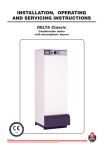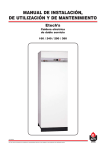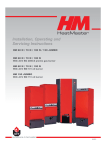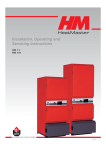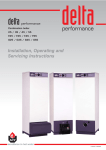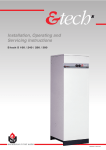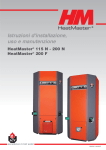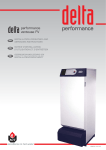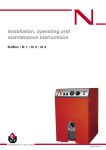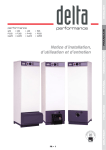Download ACV Alfa GP Specifications
Transcript
INSTALLATION, OPERATING AND SERVICING INSTRUCTIONS ALFA Gaz G/GP Dual application gas boiler with atmospheric burner 05/11/2002 ACV reserves the right to modality the technical specifications and components of its products without prior notice. 664Y0800 INDEX 1 1 INTRODUCTION 2 1.1 1.2 1.3 1.4 Intended users of these instructions Symbols Applicable standards Warnings 2 2 2 2 2 INSTALLATION 3 2.1 2.2 2.3 Boiler room Connections Electrical connection 3 3 5 3 STARTUP 6 3.1 3.2 Filling the heating and hot water circuits Atmospheric burner troubleshooting 6 6 4 SERVICING 6 4.1 4.2 4.3 4.4 4.5 4.6 Recommendation Servicing the gas boiler Servicing the safety devices Servicing the burner Emptying the boiler Spare parts 6 6 6 7 7 7 5 DESCRIPTION 8 5.1 5.2 5.3 Overview Description of operation Design features 8 8 8 6 TECHNICAL SPECIFICATION 9 6.1 6.2 6.3 6.4 6.5 Effective dimensions Maximum operating conditions Domestic hot water performance Boiler performances Atmospheric burner 9 9 10 10 10 7 USER GUIDE 12 7.1 7.2 Using the boiler Boiler room 12 13 1.1 INTRODUCTION INTENDED USERS OF THESE INSTRUCTIONS These instructions are intended for: - the specifying engineer - the installation engineer - the user - servicing technicians 1.2 SYMBOLS The following symbols are used in these instructions: Essential instruction for operating the system correctly. Essential instruction for personal safety and environmental protection. Danger of electrocution. Risk of burns. 1.3 APPLICABLE STANDARDS The products have received the “EC” certificate in accordance with the standards prevailing in different countries (European Directives 90/42/EEC, “efficiency”, 90/396/EEC “gas appliances”). These products have also received the Belgian “HR+” mark. 1.4 WARNINGS These instructions are an integral part of the equipment to which they refer and must be supplied to the user. The product must be installed and serviced by qualified engineers, in compliance with the prevailing standards. ACV accepts no liability for any damage resulting from incorrect installation or from the use of components or fittings not specified by ACV. Failure to observe instructions regarding tests and test procedures can result in personal injury or pollution risks. 2 Note: ACV reserves the right to modify the technical specifications and components of its products without prior notice. 2 2.1 INSTALLATION 2.2.2 BOILER ROOM 2.2.2.1 Examples of basic circuit configurations The drain valve and safety valve must be connected to the waste water system in accordance with current regulations. 2.1.1 ACCESSIBILITY The boiler room must be large enough to allow good access to boiler. The following minimum distances (mm) are required around the boiler: - front - rear 500 150 - sides - above CENTRAL HEATING CONNECTION 100 700 9 2.1.2 VENTILATION The boiler room must be fitted with top and bottom vents according to the table below or current regulations. 7 4 2 3 2.1.3 BASE The base on which the boiler rests must be made of non-combustible materials. 6 2.2 9 5 CONNECTION 2.2.1 CHIMNEY CONNECTION The boiler can be connected to a suitable flue or to the chimney by a metal pipe rising at an angle from the boiler to the chimney. It must be easy to remove to give access to the flue pipes when servicing the boiler. 10 Top vent Bottom vent Chimney height Chimney diameter Fig. 2: Configuration with circulator controlled by a room thermostat D C A. B. C. D. A 1. 2. 3. 4. 5. 6. 7. 8. 9. 10. 3-way manual motorisable mixer valve Safety valve pre-set to 3 bar with pressure gauge Circulator Non-return valve System filling valve Expansion tank Room thermostat ACV 13 controller (see controller kit page 5) Central heating isolating valve Drain valve B 9 9 Fig. 1: Boiler room ventilation and chimney connection 2 ALFA G 3 1 ALFA GP Ventilation 6 Min. fresh air requierement m3/h Top vent (A) dm2 Bottom vent (B) dm2 82,8 1,5 1,5 82,8 1,5 1,5 130 130 130 130 130 130 8 4 5 Chimney C = 5 m Ø min. D C = 10 m Ø min. D C = 15 m Ø min. D mm mm mm IMPORTANT Boilers must be installed by a qualified engineer, in accordance with the prevailing local standards and regulations. 10 Fig. 3: Configuration with motor driven mixer valve 3 2 INSTALLATION 2.2.2.2 ACV circulation kit ACV offers an optional pre-assembled circulation kit comprising: - a circulator. - a 3-way manual motorisable valve. - connecting pipes including a second optional circuit. - two isolating valves. - adapters for mounting expansion tank, safety valve and filling valve to right or left. 2.2.2.3 Discharge The drain valve and safety valve must be connected to the waste water system in accordance with current regulations. 2.2.3 Fig. 4: ACV circulation kit assembly DOMESTIC HOT WATER CONNECTION 2.2.3.1 Pressure reducer If the water mains pressure is greater than 6 bar, a pressure reducer calibrated to 4.5 bar must be fitted. 2.2.3.2 Safety unit The tank safety unit must be ACV approved and calibrated to 7 bar. The valve discharge must be connected to the waste water system in accordance with current regulations. 5 2 7 4 8 1 2.2.3.3 Hot water expansion tank Installing a hot water expansion tank avoids any risk of pressure surges due to water-hammer. 9 6 2.2.3.4 Hot water circulation If the tank is situated a long way from the point of use, then installing a closed return circuit can provide a faster supply of hot water always available. 2.2.3.5 1. 2. 3. 4. 5. 6. 7. 8. 9. Description Safety unit Pressure reducer Thermostatic mixing valve Hot water circulator Non-return valve Hot water expansion tank Inlet valve Draw-off valve Bleed valve Fig. 5a: Configuration without thermostatic mixing valve 5 IMPORTANT As a safety measure against burns, we strongly advise installing a thermostatic mixing valve (recommended temperature: 60° C). 2 7 4 8 1 3 9 6 Optional fittings available Safty unit Pressure reducer Thermostatic mixer Hot water expansion tank Ø 3/4” Ø 3/4” Ø 3/4” 5 litres Fig. 5b: Configuration with thermostatic mixing valve 4 2 2.2.4 INSTALLATION CONTROLLER KITS KIT 1: ACV 13.00 / Basic Basic kit for regulating flow temperature according to weather conditions. It comprises: temperature regulator with analogue timer, water temperature detector (-30/130° C), outside temperature detector (-30/50° C), 230V - 3 spindle servomotor SQY 31 and intermediate socket. Fig. 6a: kit 1 KIT 1: ACV 13.00 / Standard Basic kit for regulating flow temperature according to weather conditions. It comprises: temperature regulator with analogue timer, water temperature detector (-30/130° C), outside temperature detector (-30/50° C), 230V - 3 spindle servomotor SQY 349 and intermediate socket. Fig. 6b: kit 2 Wiring diagram of ACV controller kits (fig. 7) SQK 349 B2. B9. B5. P1. 230V P1 Water temperature detector Outside temperature detector Analogue/digital room thermostat Central heating pump B5 B9 B3 B2 QAAD50 (QAAD70) QAC32 QAD22 bl n/z br N Y1/Y2/N. Mixer valve (SQK349) 20 19 18 17 16 15 14 13 12 11 10 9 8 7 6 5 4 3 2 L1 ALIMENTATION 1 230V / 50 Hz bl. Blue N n/z. Black Y2 br. Brown Y1 20 19 18 17 16 15 14 13 12 11 N Y2 Y1 2.3 10 9 P1 8 7 B5 6 5 B9 4 3 B3 2 1 B2 ELECTRICAL CONNECTION 10 1 1 2 C T M O 5 3 2.3.2 COMPLIANCE Boiler installation must comply with the prevailing local standards and legislation. 2.3.4 BURNER ELECTRICAL CONNECTION The burner is supplied with power by a 3-core cable. N M 2.3.1 POWER SUPPLY The boiler operates with a 230 V - 50 Hz single phase supply. An isolator switch with 6 A fuses must be fitted outside the boiler to allow power to be shut off during servicing and before any repairs are carried out on the boiler. 2.3.3 SAFETY The stainless steel tank must be earthed separately. L1 B N O M. O. N. B. R. T. 6 Brown Orange Black Blue Red Green-yellow N B 2 4 B R 1 2 3 Fig. 8: Control panel The power to the boiler must be switched off before any work is carried out. 1. 2. 3. 4. 5. 6. 7. 8. 9. 10. Boiler thermostat (60/90° C) On/off switch Summer/winter selector Thermometer Flue spillage thermostat (TTB) Safety thermostat (103° C max.) Plug (power and control) Room thermostat Heating pump connection To gas valve L1 N T1 T2 S3 L1 N T1 T2 S3 230V-50 Hz 6A 7 9 8 Fig. 9: Boiler wiring diagram 5 3 3.1 START-UP FILLING THE HEATING AND HOT WATER CIRCUITS 1. Fill the domestic hot water circuit and bring it up to pressure. 4 4.1 RECOMMENDATION ACV recommends that boilers should be serviced at least once a year. The burner must be serviced and tested by a competent engineer. 4.2 IMPORTANT The hot water tank must be pressurised before the heating circuit is filled. 2. Fill the heating circuit taking care not to exceed the 2 bar pressure limit. 3. Vent the air from the top of the boiler. 4. After venting the air from the system, bring the pressure up to the static head plus 0.5 bar: 1.5 bar = 10 m – 2 bar = 15 m. 5. Check the power connection, the boiler room ventilation, and ensure that there are no leaks in the flue gas discharge pipes. 6. Set the thermostat (1) to between 60 and 90° C. SERVICING THE GAS BOILER 1- Switch off the power at the mains switch outside the boiler and close the gas tap. 2 - Set the on/off switch on the control panel to the OFF position. 3 - Release and remove the chimney flue (1) to free the top of the boiler. 4 - Remove the jacket top (2) and lift off the flue reducer (3). 5 - Remove the baffles (4) from the flue pipes (5) for cleaning. Replace them if in poor condition. 6 - Unscrew the burner chamber plate (6). 7 - Brush the flue pipes (5). 8 - Clean the burner chamber (7) and the burner (8). 9 - Check that the insulation on the burner chamber plate (6) is in good condition. 1. 2. 3. 4. 5. 6. 7. 8. 1 2 3 SERVICING Fig. 10: Control panel Chimney flue Jacket top Chimney flue reducer Baffles Flue pipes Burner chamber plate Burner chamber Burner 7. Set the Summer/Winter selector (3) to the desired position. 8. Switch the on/off switch (2) to the ON position. 9. Check the gas supply pressure on starting up. 3.2 1 BURNER TROUBLESHOOTING 3 2 Refer to the servicing and troubleshooting instructions for the burner. Before servicing or repairs, switch off the power at the mains switch fitted in the boiler room by the electrician. 5 4 6 7 8 Fig. 11: Main components. 4.3 - - 6 SERVICING THE SAFETY DEVICES Check that all thermostats and safety devices are working properly: boiler thermostat, cut-off thermostat and manual reset safety thermostat. Test the safety valves on the central heating and hot water circuits. 4 4.4 SERVICING SERVICING THE BURNER - Check and clean the burner and ignition electrode. - Check that the safety components are working properly. 4.5 EMPTYING THE BOILER 4.5.1 EMPTYING THE PRIMARY CIRCUIT (central heating): 1 1 1. Switch off the power to the boiler at the mains switch installed by the electrician. 2. Close the isolating valves (1) of the boiler system. 3. Connect a hose to the drain valve (2). Ensure that it is attached properly. 4. Open the drain valve and let the hot water drain out. 2 5. When the boiler is empty, return the isolating and safety valves to their initial positions. 4.5.2 Fig. 12a: Emptying the primary circuit EMPTYING THE HOT WATER TANK: 1. Switch off the mains power to the boiler at the external switch installed by the electrician. 2. Relieve the pressure in the primary circuit. 3. Close valves (A) and (B). 4. Open valves (C) and (D) (first C then D). 5. Let the water drain away. B A D 6. After emptying, return the valves to their initial positions. For the tank to be emptied, valve (C) must be situated at ground level. 4.6 SPARE PARTS C Refer to the specific document available from ACV or your distributor. Fig. 12b: Emptying the hot water circuit 7 5 5.1 • • • • • • • • • DESCRIPTION OVERVIEW Dual application boiler (central heating and domestic hot water). Designed for connection to a chimney or suitable flue. TANK-IN-TANK indirect storage type domestic hot water production. Fittings for connecting the circulation kit to feed the heating circuit (available as an option). Control panel with setting thermostat (60/90 °C), on/off switch, Summer/Winter selector, thermometer, warning lamp and burner reset button. Flue gas anti-backdraught safety device. Delivered complete with atmospheric type burner. ALFA G for natural gas, with rated output of 20.3 kW. ALFA GP for propane, with rated output of 23.5 kW. 5.3 DESIGN FEATURES 5.3.1 OUTER BODY The outer body containing the primary fluid is made of STW 22 steel. 5.3.2 TANK-IN-TANK TYPE EXCHANGER ACCUMULATOR The ring-shaped inner tank with its large heating surface for producing domestic hot water is built of Chrome/Nickel 18/10 stainless steel. It is corrugated over its full height by an exclusive production process and entirely by argon arc welded by the TIG (Tungsten Inert Gas) method. 5.3.3 COMBUSTION GAS CIRCUIT The combustion gas circuit is protected by cold galvanisation. The combustion gas circuit comprises: 5.3.3.1 Flue pipes Depending on output, ALFA Gas models contain 4 or 8 steel flue pipes with an internal diameter of 64 mm. Each pipe is fitted with a baffle of special steel designed to improve heat exchange and reduce flue gas temperature. 5.3.3.2 Combustion chamber The combustion chamber on ALFA Gas models is water cooled. 5.3.4 INSULATION The boiler body is fully insulated by rigid polyurethane foam with a high thermal insulation coefficient, sprayed on without the use of CFCs. Fig. 13: Ballon inox sanitaire 5.2 DESCRIPTION OF OPERATION 5.2.1 THE TANK-IN-TANK CONCEPT The ALFA Gas series differs from traditional hot water producers because of its ring-shaped tank immersed in the primary fluid contained in the outer body. When there is a demand for hot water from the central heating system or the domestic hot water system, the thermostat starts the burner. The combustion gases quickly heat up the primary fluid, creating a natural circulation around the tank. 5.2.2 5.3.6 BURNER ALFA Gas boilers are fitted with an atmospheric burner with electric ignition. 5.3.7 1 2 3 4 DOMESTIC HOT WATER HEATED INDIRECTLY This circulation facilitates heat exchange between the primary fluid and the domestic water, which takes place all over the tank surface. The corrugations on the inner and outer shells of the ring-shaped tank further boost the area of heat exchange and speed up the heating process of the domestic water. 5.2.3 5.3.5 JACKET The boiler is covered by a steel jacket which has been scoured and phosphated before being stove enamelled at 220° C. CONTROL PANEL (Fig. 14) - Thermostat adjustable between 60 and 90° C - On/off switch - Summer/winter selector - Thermometer 4 1 2 EASY SETTING AND SAFETY ASSURED With a single command, the water temperature of both the primary circuit and the hot water circuit is set by the adjustable thermostat situated on the tank in the primary circuit. A manually reset safety thermostat shuts off the burner if the temperature reaches 103° C. 8 3 Fig. 14: Control panel 5 DESCRIPTION 23 Boiler components Fig. 15 1. 2. 3. 4. 5. 6. 7. 8. 9. 10. 11. 12. 13. 14. 15. 16. 17. 18. 19. 20. 21. 22. 23. 24. Chimney flue Domestic hot water outlet Central heating return Central heating flow pipe Inner ring-shaped domestic hot water tank Sprayed-on polyurethane foam insulation Flue pipes Baffles External body containing central heating circuit Burner chamber disk Boiler drain Combustion chamber Boiler base Burner flame holder Burner chamber cap Burner chamber door Thermometer / boiler thermostat bulb Front Control thermostat 60/90 °C Manual reset safety thermostat 103 °C Casing top Domestic cold water flow pipe Flue spillage thermostat (TTB) Chimney reducing adapter 6 6.1 1 2 22 3 21 4 20 5 19 6 18 7 17 8 16 9 10 15 14 12 13 11 TECHNICAL SPECIFICATION EFFECTIVE DIMENSIONS Dimensions ALFA G ALFA GP A 1363 1363 B 130 130 C 685 685 D 390 390 Kg 143 143 The units are delivered fully assembled, tested and packed on a timber base with shockproof edges and protected by heat-shrunk plastic film. On reception and after unpacking, check the equipment for damage. For transport purposes, refer to the weights and dimensions given opposite. 6.2 24 MAXIMUM OPERATING CONDITIONS 569 B Maximum service pressure (tank full of water) - Primary circuit: 3 bar - Secondary circuit: 10 bar Test pressure (tank full of water) - Primary circuit: 4.5 bar - Secondary circuit: 13 bar 200 A 160 125 Operating temperature - Maximum temperature: 90° C 542 C D Fig. 16: Effective dimensions 9 6 6.3 TECHNICAL SPECIFICATION DOMESTIC HOT WATER PERFORMANCE Domestic hot water performances ALFA G ALFA GP Operating at 80° C Peak delivery at 40° C (6T = 30° C) litres/10’ 170 170 Peak delivery at 40° C (6T = 30° C) litres/60’ 653 665 Continuous delivery 40° C (6T = 30° C) litres/h 579 594 Initial heating time minutes 24 24 After draw-off of 140 l at 45° C minutes 17 16,5 Operating at 80° C Results obtained without a thermostatic mixing valve and with water supply at 10° C 6.4 BOILER PERFORMANCES ALFA G ALFA GP 23,5 Input kW 23 Output kW 20,3 20,7 % 90,7 91,3 Combustion efficiency Maintenance loss at 60° C as % of rate value Mass rate of combustion products Average CO2 % 1 1 g/sec. 18 19 9,5 % 8,5 Total capacity litres 99 99 Primary circuit capacity litres 56 56 Heating connection Ø 1” 1” Hot water connection Ø 3/4” 3/4” Hot water tank heat exchange surface m2 1,42 1,42 Weight empty Kg 143 143 B11 BS B11 BS Chimney connection 6.5 ATMOSPHERIC BURNER ALFA G ALFA GP mbar m3/h 9,8 2,43 - mbar m3/h - 21,2 0,94 450 3x160 Gas G20 - 20 mbar - I E2+ - I 2E LL Burner pressure Flow rate Gas G31 - 37/50 mbar - I 3P Burner pressure Flow rate Injector Ø 1/100 mm BE - FR AT - DK - ES - GB - IT - PT - IE - SE BE - FR - ES - GB - IE - PT NL LU - DE I E2+ I 2H I 3P I 2L I 2ELL 10 6 TECHNICAL SPECIFICATION Description 1. 2. 3. 4. These atmospheric burners are fitted with a SIT gas valve and an electrically operated relay. This gas valve has been specially developed for atmospheric burners with automatic ignition and ionisation flame detection. Electrically operated gas valves. Upstream gas pressure test point. Pressure regulator Gas burner pressure test point. 1 Advantage • • • No pilot flame, therefore no gas consumption when when the boiler is off. The burner only operates when there is a demand for hot water. The electric ignition requires no action. Starting • • • Flush the gas pipe thoroughly, turn on the room thermostat and switch the control thermostat to heat demand. Open the gas tap. Turn on the main switch on the control panel. 4 3 2 Fig. 17: Burner gas valve The burner is preset at the factory. Check the supply pressure and the pressure in the burner when starting the boiler. Natural gas atmospheric burner (fig.18) 1. 2. 3. 4. 5. 6. 7. 8. 1 Burner plug connector Pot type flame holder Ignition and ionisation electrode Observation window Injector Relay Reset button Burner chamber plate 2 8 3 7 6 5 Propane gas atmospheric burner (fig.19) 1. 2. 3. 4. 5. 6. 7. 8. 4 1 Ignition and ionisation electrode Flame holder Burner chamber plate Injectors Reset button Gas valve Relay Observation window 2 8 7 6 3 5 4 11 7 USER GUIDE 7.1 USING THE BOILER 7.1.2 7.1.1 GETTING TO KNOW THE CONTROL PANEL (Fig. 20) Your system is fitted with a heating safety valve set to 3 bar, with a pressure gauge. Before doing any work on the boiler, switch off the power at the mains switch installed in the boiler room by the electrician. On the control panel, switch off the ON/OFF switch. Ensure that the water in the system is always pressurised. When cold, and after the air in the system has been vented, the pressure gauge must show a pressure between 0.5 and 1.5 bar, depending on the height of the building (1 bar = 5m / 1.5 bar = 10 m and 2 bar = 15 m). To add water, open the filling valve (Fig. 2 and 3 page 3). Close the valve after filling. Vent the air in the system to get an accurate water pressure reading. (item 2, Fig. 20) 1 - Control thermostat 60° to 90° C (item 1, Fig. 20). Central heating systems are generally designed to operate at 80° C maximum. If they are operated at a lower temperature, a 3-way mixer valve installed on the heating flow pipe (see Fig. 3, page 3) allows the temperature to be set manually or, if you decide to install a regulator (§ 2.2.4, page 5), automatically. We recommend you set the thermostat to the maximum values to get the best from the domestic hot water system. 7.1.3 HEATING SYSTEM GAUGE PRESSURE SAFETY VALVE (central heating) (item 2, Fig. 3, page 3) Water flowing out of the safety valve is extremely hot and can cause serious burns. The discharge pipe to the drain must be iaw current regulations. Keep people away from discharges of hot water. In the event of a fault after this short trial, inform the installing engineer. The water stored in the domestic hot water tank in the boiler can be at a very high temperature. In all cases, install the thermostatic mixer (Fig. 5b, page 4) on the domestic hot water flow pipe which must not exceed 60° C. A blender or mixing valve is recommended at each point of use. 2 - ON/OFF switch (item 2, Fig. 20). This must be used to switch off the boiler before working on it. 3 - Summer/winter selector (item 3, Fig. 20) “Winter” position: activates both the hot water and central heating functions. “Summer” position: the room thermostat or regulator (§ 2.2.4, page 5) is switched off. The heating circulator is also switched off. Only the domestic hot water function is provided. You can lower the temperature on the thermostat (1) to save energy. If there is not enough hot water, we recommend setting the thermostat (1) to its maximum value. When the next heating season begins, simply select “Winter” to reactivate the heating system. 4 - Thermometer (item 4, Fig. 20) Reads the temperature of the boiler primary circuit (central heating) directly. 4 1 2 3 12 Fig. 20: Control panel 7.1.4 SAFETY UNIT (domestic hot water) (item 1, Fig. 5a and 5b, page 4) A monthly inspection is recommended. Lift the lever on the emptying device for a few seconds to ensure that the safety valve is working properly. Water flowing out of the safety valve is extremely hot and can cause serious burns. The discharge pipe to the drain must be iaw current regulations. Keep people away from discharges of hot water. In the event of a fault after this short trial, inform the installing engineer. 7 7.1.5 USER GUIDE GAS BURNER - RESETTING If the atmospheric burner is not working: 1. Remove the protective cover. 2. Press the red button to start the burner. 7.2 BOILER ROOM • • • • Keep vents free at all times. Do not store inflammable products in the boiler room. Take care not to store corrosive products near the boiler, such as paints, solvents, chlorine, salt, soap and other cleaning products. If you smell gas, do not switch on the light or light a flame. Turn off the mains gas tap at the meter and inform the appropriate services immediately. Fig. 21: Burner reset button If the burner is not working, isolate the electricity supply before attempting to reset the safety thermostat. 3. Remove the circular cover on the boiler top and press the red safety thermostat button . Wait until the boiler temperature is below 60° C then replace the casing front panel. Fig. 22: Safety thermostat reset button 4. If the burner lights, replace the cover. 6. If the fault persists, notify the installing engineer. Starting the burner. In normal operation, the gas burner starts automatically whenever the boiler temperature falls below the set temperature. To ensure your system operates properly, have it professionally serviced once a year before the central heating season begins. 13 INTERNATIONAL ACV international n.v KERKPLEIN, 39 B-1601 RUISBROEK - belgium TEL.: +32 2 334 82 20 FAX: +32 2 378 16 49 E-MAIL: [email protected] AUSTRALIA ESPAÑA PORTUGAL ACV PACIFIC PTY.LTD UNIT 7, 10 ANELLA AVENUE CASTLE HILL NSW 2154 - AUSTRALIA TEL.: +61 2 88 50 45 88 FAX: +61 2 88 50 45 99 E-MAIL: [email protected] ACV ESPAÑA C/ANTONIO GAUDI, 3 E-08349 CABRERA DE MAR - ESPANA TEL.:+34 937 595 451 FAX:+34 937 593 498 E-MAIL: [email protected] BELGIUM FRANCE BOILERNOX LDA RUA OUTEIRO DO POMAR CASAL DO CEGO, FRACÇÃO C, PAVILHÃO 3 - MARRAZES 2400-402 LEIRIA - PORTUGAL TEL.:+351 244 837 239/40 FAX:+351 244 823 758 E-MAIL: [email protected] ACV BELGIUM nv/sa KERKPLEIN, 39 B-1601 RUISBROEK-BELGIUM TEL.: +32 2 334 82 40 FAX: +32 2 334 82 59 E-MAIL: [email protected] ACV FRANCE sa 31, RUE AMPERE - Z.I MI - PLAINE F-69680 CHASSIEU - FRANCE TEL.:+33 4 72 47 07 76 FAX:+33 4 72 47 08 72 E-MAIL: [email protected] CHILE ITALIA ALBIN TROTTER Y ACV LTDA SAN PABLO 3800 QUINTA NORMAL - SANTIAGO - CHILE TEL.:+56 2 772 01 69 FAX:+56 2 772 92 62/63 E-MAIL: [email protected] ACV ITALIA VIA MALPIGHI 6 I-48018 FAENZA (RA) - ITALIA TEL.:+39 0546 62 25 15 FAX:+39 0546 62 25 05 E-MAIL: [email protected] CZECH REPUBLIC NEDERLAND ACV CR SPOL. s.r.o NA KRECKU 365 CR-109 04 PRAHA 10 - CZECH REPUBLIC TEL.:+420 2 720 83 341 FAX:+420 2 720 83 343 E-MAIL: [email protected] ACV NEDERLAND bv POSTBUS 350 NL-2980 AJ RIDDERKERK - NEDERLAND TEL.:+31 180 42 10 55 FAX:+31 180 41 58 02 E-MAIL: [email protected] DEUTSCHLAND POLAND ACV DEUTSCHLAND Gmbh GEWERBEGEBIET GARTENSTRASSE D-08132 MÜLSEN ST.JACOB - DEUTSCHLAND TEL.:+49 37601 311 30 FAX:+49 37601 311 31 E-MAIL: [email protected] ACV POLSKA sp. z.o.o. BUIRO GLOWNE PL-87 - 702 KONECK - POLAND TEL.:+48 54 272 23 00 FAX:+48 54 272 23 01 E-MAIL: [email protected] ARGENTINA GREECE ROMANIA TECNOPRACTICA ALFEREZ BOUCHARD 4857 1605 CARAPACHAY - BUENOS AIRES TEL.: +54 11 47 65 33 35 FAX: +54 11 47 65 43 07 E-MAIL: [email protected] ESTIAS MARASLI STREET 7 54248 THESSALONIKI - GREECE TEL.:+30 310 31 98 77 FAX:+30 310 31 97 22 E-MAIL: [email protected] SC TRUST EURO THERM SA D.N PIATRA NEAMT - ROMAN km 2 C.P 5 O.P 3 jud. Neamt 5600 PIATRA NEAMT - ROMANIA TEL.:+40 233 20 62 06 FAX:+40 233 20 62 00 E-MAIL: [email protected] BRAZIL ÎLE MAURICE SIMETAL INDUSTRIA E COMERCIO DE FERRAMENTAS LTDA RUA GERSON ANDREIS 535 95112 - 130 CAXIAS DO SUL - BRAZIL TEL.: +55 54 227 12 44 FAX: +55 54 227 12 26 E-MAIL: [email protected] SOTRATECH 29, RUE MELDRUM BEAU BASSIN - ÎLE MAURICE TEL.:+230 46 76 970 FAX:+230 46 76 971 E-MAIL: [email protected] RUSSIA ACV RUSSIA 1/9, MALYI KISELNYI 103031 MOSCOW - RUSSIA TEL.:+7 095 928 48 02 / +7 095 921 89 79 FAX:+7 095 928 08 77 E-MAIL: [email protected] SLOVAK REPUBLIC ACV SLOVAKIA s.r.o. PLUHOVÁ 49 831 04 BRATISLAVA - SLOVAK REPUBLIC TEL.:+421 2 444 62 276 FAX:+421 2 444 62 275 E-MAIL: [email protected] UK ACV UK Ltd ST. DAVID’S BUSINESS PARK DALGETY BAY - FIFE - KY11 9PF - SCOTLAND TEL.:+44 1383 82 01 00 FAX:+44 1383 82 01 80 E-MAIL: [email protected] USA TRIANGLE TUBE PHASE III FREEWAY CENTER - 1 TRIANGLE LANE BLACKWOOD NJ 08012 - USA TEL.:+1 856 228 8881 FAX:+1 856 228 3584 E-MAIL: [email protected] SLOVENIA Z*MAJ d.o.o. CESTA OF 49 1420 TRBOVLJE - SLOVENIA TEL.:+386 356 32 830 FAX:+386 356 32 831 E-MAIL: [email protected] LITHUANIA BULGARIA PROXIMUS ENGINEERING LTD 7 BIAL KREM STR. 9010 VARNA - BULGARIA TEL.:+359 52 500 070 FAX:+359 52 301 131 E-MAIL: [email protected] CHINA BEIJING HUADIAN HT POWER TECHNOLOGY DEVELOPMENT CO. LTD ROOM B-912, TOWER B, COFCO PLAZA N°. 8, JIANGUOMENNEI AVENUE BEIJING 100005 - PEOPLE’S REPUBLIC OF CHINA TEL.:+86 10 652 30 363/393 EXT 101 FAX:+86 10 652 27 071 E-MAIL: [email protected] DENMARK VARMEHUSET FRICHSVEJ 40 A 8600 SILKEBORG - DENMARK TEL.:+45 86 82 63 55 FAX:+45 86 82 65 03 E-MAIL: [email protected] ESTONIA TERMOX AS TAHE 112A 51013 TARTU - ESTONIA TEL.:+372 736 73 39 FAX:+372 736 73 44 E-MAIL: [email protected] UAB “GILIUS IR KO” SAVARNORIU PR. 192 3000 KAUNAS - LITHUANIA TEL.:+370 37 308 930/931 FAX:+370 37 308 932 MAROC CASATHERM PLACE EL YASSIR 20300 CASABLANCA - MAROC TEL.:+212 22 40 15 23 FAX:+212 22 24 04 86 MOLDAVIA STIMEX - PRIM S.R.L. STR BUCURESTI, 60A 2012 CHISINAU - MOLDAVIA TEL.:+37 32 22 46 75 FAX:+37 32 27 24 56 E-MAIL: [email protected] ÖSTERREICH PROTHERM HEIZUNGSTECHNIK Gmbh TRAUNUFERSTRASSE 113 4052 ANSFELDEN - ÖSTERREICH TEL.:+43 7229 804 82 FAX:+43 7229 804 92 E-MAIL: [email protected] SWEDEN WÄRMEPRODUKTER I KLIPPAN AB TEMPLAREGATAN 7 26435 KLIPPAN - SWEDEN TEL.:+46 435 184 10 FAX:+46 435 184 02 E-MAIL: [email protected] TUNISIE SO.CO.ME CHAUMAX BOÎTE POSTALE N°44 1002 TUNIS - TUNISIE TEL.:+216 71 78 15 91 FAX:+216 71 78 87 31 UKRAINE UKRTEPLOSERVICE LTD PR. LAGUTENKO 14 83086 DONETSK - UKRAINE TEL.:+38 062 382 60 47/48 FAX:+38 062 335 16 89 E-MAIL: [email protected]














